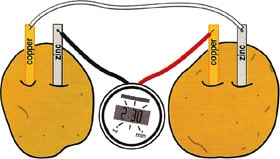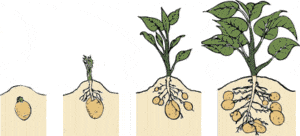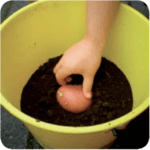Looking for creative and educational ways to keep your little ones entertained? Try these fun potato activities! Perfect for sparking creativity and learning through play.
- Potato Stamps: Cut potatoes into fun shapes and use them as stamps with paint.
- Potato Science: Watch a potato sprout and learn about plant growth.
- Potato Crafts: Make cute potato characters with googly eyes and markers.
- Potato Games: Set up a potato sack race or a hot potato game.
- Try some of the activities suggested below:
How to build a potato clock
 You will need:
You will need:
- a digital clock
- two potatoes
- wire
- zinc plate
- copper plate
Buy the parts at an electronics shop.
Instructions:
- Check all the wires are securely connected (see diagram).
- Put one copper plate and one zinc plate into each potato. The plates need to be about two centimetres deep, and about two centimetres apart.
- Set the time on your clock – it should now be working.
How does it work?
Potatoes are full of a mineral called phosphoric acid, which reacts differently with each of the metal plates (one copper and one zinc) in your potato. Phosphoric acid dissolves the zinc plate, freeing electrons, which react with the copper plate to form hydrogen gas.
The potato acts as a superhighway of electrons between the copper and zinc plates. This flow of electrons is the electrical current that makes your clock work.
 Growing potatoes in a bucket
Growing potatoes in a bucket
You can grow your own potatoes in a bucket – they will take around 60-70 days and then they will be ready to be harvested.
Growing your potato
Light
Plants need light to grow, so put the potato plant somewhere in the light.
Water
Potatoes need water to grow, but don’t water it too much or the potato will go mouldy. The soil should be damp so water every 3-4 days.
Food
Potatoes need food to grow and this comes from the nutrients in the soil. Compost should contain everything your potato needs. If extra potato food is added make sure to read the instructions carefully.
Temperature
The ideal temperature for growing potatoes is 10-15°C.
Space
The more room the plant has the better so even though these instructions are for growing potatoes in a bucket, potatoes planted in the garden will give better results.
Note: Do not eat any of the growing potato plant – only the potatoes can be eaten.
Planting instructions
 You will need:
You will need:
- a bucket
- 1 seed potato
- compost or soil
Make sure your seed potato is starting to sprout before planting. If there are no sprouts the potato may take ages to start to grow.
Make a drainage hole in the bottom of a bucket; an adult should do this. It can be done using a hammer and nail.
Place enough fresh dry topsoil in the bucket so it is about one third full.
Push in one seed potato per bucket and make sure it is covered with 1 cm soil.
Water the soil so it is damp; you will need about one cup of water. The soil should only be damp, not wet. The potato does not need much water until the top is growing.
Place the bucket in a warm and sunny spot. The plants will need sunshine, this can be indoors beside a window or outdoors. The plant will respond well to being outside in the sunshine but if you are growing them over winter they must come in at night to be protected from frosts. It is essential that the plant is not frosted.
Once the shoots appear keep the soil damp but not wet. If it does get over-watered put it in the sun without extra water until it is back to being damp. Over-watering will slow growth.
Once the tops start to die off the potatoes are ready to harvest. This will take around 60-70 days.
- easy to prepare
- nutritious
- readily available
- economically attainable
- popular and tasty
- locally grown
- environmentally sustainable
- an integral part of our culture.
Check out some Potato Recipes >> as well as some tips for Cooking Potatoes >>



